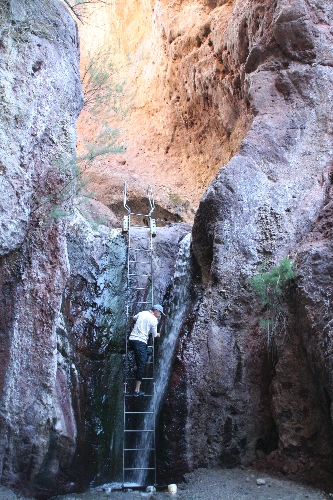Beat the heat at Arizona Hot Springs
With the temperatures warming up, it's almost time to wrap up the spring hiking season in Lake Mead National Recreation Area. With that in mind, you might want to sneak in one more low-elevation trail before it becomes unbearably hot and unsafe to do so.
One fine choice is a trip to Arizona Hot Springs, a roundtrip hike of less than six miles, with an elevation loss of about 800 feet. This time of year, you will want to arrive at the trailhead first thing in the morning to avoid the afternoon heat. The hike offers very little shade, and the return to your vehicle is all uphill.
The trailhead is easy to find and located only four miles south of the Hoover Dam bypass. From the parking area, follow the trail down the embankment and go right, or downstream, under the highway. This is White Rock Canyon, which starts off as a wide rocky wash but then narrows, and you will then be walking in soft gravel within high walls of volcanic rock.
After about 2.6 miles, you will arrive on the banks of the Colorado River. Head downstream and pick up the faint path that leads up and over a hill. Drop down on the other side, and you will be in a narrow yet nicely vegetated canyon with a small ribbon of warm water flowing down it and eventually into the river. Head left, or upstream, following the streambed. Water shoes are nice to have from here on up into the hot springs as your feet will get wet.
In a few minutes, you will be at the base of a small waterfall. Beside it is 20-foot metal ladder that allows access to the hanging canyon above. In this canyon, you will find several pools of water that have been formed by small dams built of sandbags. The spring waters flow about 400 gallons per minute, and the farther upstream you go, the warmer the water will be. Heated by molten rock, the waters move to the surface through faults and arrive highly mineralized with chloride, sulphate, sodium, potassium and other natural chemicals. If you failed to carry enough drinking water, it's better to replenish your supply from the Colorado itself, but any water in these parts requires treatment before drinking.
The best days to come and soak are Sundays and Mondays as the river is then closed to PWCs and other vessels with motors from Willow Beach upstream to Hoover Dam, which limits the number of visitors. But there will still be some arriving from kayak, canoe and raft excursions. Your best bet for any solitude is to get in here early in the day and then head home before it gets busy.
A word of warning on the hot springs: The water might contain an amoeba called Naegleria fowleri that is common in thermal pools. This could cause a rare infection and even death. Be careful never to submerge your head or get water in your nose or mouth.
There are also rattlesnakes out and about this time of year, so be careful where you place your hands or feet.
This is also not a hike to do if it is raining or rain threatens, as this is an extreme flash flood area.
Deborah Wall is the author of "Great Hikes, A Cerca Country Guide" and "Base Camp Las Vegas: Hiking the Southwestern States," published by Stephens Press. She can be reached at deborabus@aol.com.






















